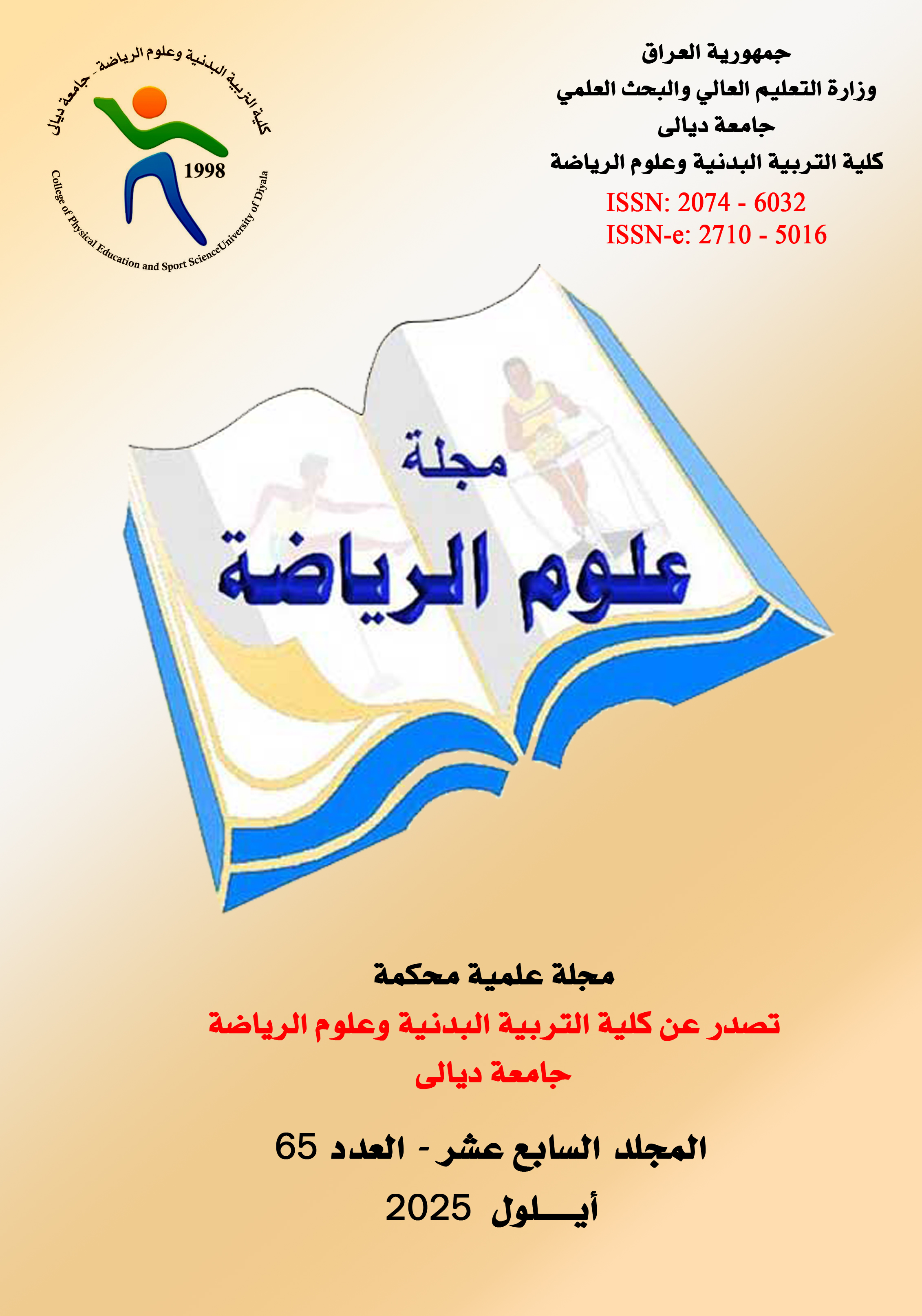The Relationship Between Physical Activity and Mental Health
محتوى المقالة الرئيسي
الملخص
This study aimed to investigate the relationship between physical activity levels and mental health outcomes among adults aged 18-65 years in an urban setting. Specifically, it sought to determine whether higher levels of physical activity are associated with lower psychological distress, as measured by the General Health Questionnaire (GHQ-12). Participants were recruited from community centers, gyms, and online platforms, resulting in an initial sample of 500 individuals. After applying inclusion (physically capable adults) and exclusion criteria (individuals with diagnosed mental health disorders), 450 participants completed the study. The final sample comprised 220 females (48.9%) and 230 males (51.1%), with a mean age of 34.5 years (SD = 12.3). Physical activity was assessed using the International Physical Activity Questionnaire (IPAQ), while mental health was evaluated with the GHQ-12. Demographic and lifestyle variables, including age, gender, smoking status, and sleep quality, were collected via a structured questionnaire. Data were analyzed using SPSS version 26.0, employing descriptive statistics, Pearson correlation coefficients, and multiple regression analysis to explore the relationships among variables.
The mean total physical activity score was 1,200 MET-min/week (SD = 800), with leisure-time activities contributing the most (mean = 750 MET-min/week, SD = 600). The mean GHQ-12 score was 3.5 (SD = 2.5), indicating low psychological distress, though 25% of participants scored above the cutoff of 4. A significant negative correlation was observed between total physical activity and GHQ-12 scores (r = -0.45, p < 0.001), suggesting that higher physical activity levels are associated with lower psychological distress. Multiple regression analysis revealed that total physical activity (β = -0.32, p < 0.001) and sleep quality (β = -0.25, p < 0.01) were significant predictors of mental health, explaining 18% of the variance in GHQ-12 scores (R² = 0.18). Moderating effects of demographic and lifestyle variables were not significant. The calculated effect size for the relationship between physical activity and mental health was medium (Cohen’s d = 0.50).
تفاصيل المقالة
القسم

هذا العمل مرخص بموجب Creative Commons Attribution 4.0 International License.
كيفية الاقتباس
المراجع
• Abdulridha, Samer & Shalan, Ayad. (2023). Mental health and its relationship to the accuracy of decision-making for referees in the Premier League in handball. Sports Culture. 14. 378-390. 10.25130/sc/23/2/21.
• Bandura, A. (1997). Self-efficacy: The exercise of control. W.H. Freeman.
• Boecker, H., Spranger, J., & W. (2008). The runner's high: An endorphin-mediated effect. Neuroscience Letters, 431(2), 100-104.
• Carron, A. V., Hausenblas, H. A., & Mack, D. E. (2002). The relationship between social support and exercise adherence. Journal of Sport & Exercise Psychology, 24(2), 145-158.
• Cohen, S., & Wills, T. A. (1985). Stress, social support, and the buffering hypothesis. Psychological Bulletin, 98(2), 310-357.
• Craft, L. L., & Perna, F. M. (2004). The benefits of exercise for the clinically depressed. Primary Care Companion to The Journal of Clinical Psychiatry, 6(3), 104-111.
• Dhabhar, F. S. (2009). Enhancing versus suppressing effects of stress on immune function: Implications for health. Journal of Trauma Stress, 22(1), 1-8.
• Dishman, R. K., & Buckworth, J. (1996). Increasing physical activity: A quantitative synthesis. Medicine and Science in Sports and Exercise, 28(6), 706-719.
• Dohrenwend, B. P. (Ed.). (1998). Adversity, stress, and psychopathology. Oxford University Press.
• Eime, R. M., Young, J. A., Harvey, J. T., & Payne, W. R. (2013). A systematic review of the psychological and social benefits of participation in sport for people with disabilities. Disability and Rehabilitation, 35(12), 1040-1050.
• Engel, G. L. (1977). The need for a new medical model: A challenge for biomedicine. Psychosomatic Medicine, 39(2), 139-160.
• Erickson, K. I., Voss, M. W., Prakash, R. S., & et al. (2011). Exercise training increases size of hippocampus and improves memory. Proceedings of the National Academy of Sciences, 108(7), 3017-3022.
• Faulkner, G., & Tamminen, K. (2016). Youth sport and mental health. In Routledge handbook of youth sport (pp. 406-423). Routledge.
• Gould, D., & Udry, E. (1994). Psychological skills for enhancing performance: The mental training program. In J. M. Williams (Ed.), Applied sport psychology: Personal growth to peak performance (pp. 243-265). McGraw-Hill.
• Holt, N. L., Tamminen, K. A., Tink, L. N., & Black, D. E. (2017). An interpretive description of the social support experiences of youth sport coaches. International Journal of Sport Psychology, 48(1), 1-20.
• Kessler, R. C., Berglund, P., Demler, O., Jin, R., Merikangas, K. R., & Walters, E. E. (2005). Lifetime prevalence and age-of-onset distributions of DSM-IV disorders in the National Comorbidity Survey Replication. Archives of general psychiatry, 62(6), 593-602.
• Kumar, H., Manoli, A. E., Hodgkinson, I. R., & Downward, P. (2018). Sport participation: From policy, through facilities, to users’ health, well-being, and social capital. Sport management review, 21(5), 549-562.
• McAuley, E., Rudolph, D. L., & et al. (2000). Physical activity, self-efficacy, and self-esteem in older adults. Health Psychology, 19(2), 164-170.
• Rebar, A. L., Stanton, R., Geard, D., Short, C., Duncan, M. J., & et al. (2015). A meta-meta-analysis of the relationship between physical activity and mental health. Health Psychology Review, 9(3), 1-20.
• Scully, D., Kremer, J., Meade, M. M., Graham, R., & Dudgeon, K. (1998). Physical exercise and psychological well-being: A critical review. British Journal of Sports Medicine, 32(2), 111-120.
• Thompson, W. R., Gordon, N. F., & Pescatello, L. S. (2010). ACSM's Guidelines for Exercise Testing and Prescription. Lippincott Williams & Wilkins.
• Tsatsoulis, A., & Fountoulakis, S. (2006). The influence of stress on the development of diabetes mellitus. Diabetes Research and Clinical Practice, 73(1), 1-12.
• Vella, S. A. (2019). Mental health and organized youth sport. Kinesiology Review, 8(3), 229-236.
• Weiss, M. R., & Chaumeton, N. R. (1992). Motivational orientations in sport. In T. S. Horn (Ed.), Advances in sport psychology (pp. 61-99). Human Kinetics.
• World Health Organization. (2021). The World Health Report 2021: Mental health: new understanding, new hope.
